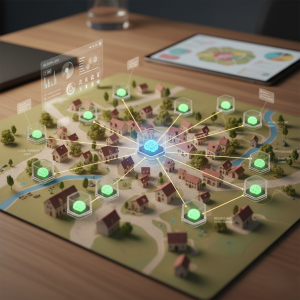Micro LLMs – The Future of AI is Local, Private, and Fast
Micro LLMs – The Future of AI is Local, Private, and Fast
 What are Micro LLMs?
What are Micro LLMs?
Forget the 100+ billion parameter giants for a moment. Micro LLMs are scaled down versions, typically ranging from 1 million to 7 billion parameters. They are designed to be:
- Efficient: Run on consumer hardware (laptops, phones) or small edge devices such as a Raspberry Pi or Jetson.
- Fast: Low latency as inference happens on device.
- Private: Your data never leaves your device.
- Affordable: No API costs, perfect for scaling applications.
Why the Push for Localized AI?
The “cloud-only” AI model has limitations. Local AI solves critical problems:
- Privacy & Security: Sensitive data (health, legal, personal notes) is processed locally. No data breaches, no vendor trust issues.
- Latency: For real time applications (translation, assistants, robotics), waiting for a cloud round trip is a deal breaker. Local is instant.
- Cost: API calls for large volumes are expensive. A one time cost to run a small model locally is often cheaper.
- Offline Functionality: AI in remote areas, on planes or anywhere without a reliable internet connection.
- Reliability: No dependency on a third party’s uptime.
The Core Technology: How Do They Do It?
Making big models small without losing all their capability is the magic. Key techniques include:
- Knowledge Distillation: A large, powerful “teacher” model trains a small, efficient “student” model.
- Quantization: Reducing the numerical precision of the model’s weights (e.g: from 32-bit to 4-bit). This drastically shrinks memory and compute needs.
- Architectural Innovations: Models like Mamba challenge the traditional Transformer architecture, offering faster inference and smaller memory footprints for long sequences.
- Better Training Data: “Tiny” models are often trained on extremely high quality, curated datasets. Quality over quantity.
Key Players & Examples (The All Stars)
This space is exploding, but here are the current champions:
- Microsoft’s Phi-3 (mini & small): The current gold standard. ~3.8B parameters, rivals models many times its size. Runs on a phone.
- Google’s Gemma 2B & 7B: Open weight models from google, performant and well supported.
- Mistral 7B: A powerhouse that proved a 7B model could be incredibly capable, sparking much of this trend.
- Llama 3 (8B): Meta’s offering, a fantastic balance of performance and efficiency.
- Alibaba’s Qwen2.5 (0.5B, 1.5B, 7B): A strong series with models at multiple scales.
- Specialized Models:
-
-
- CodeLlama (7B): For local code generation and explanation.
- Llava & BakLLaVa: Small multimodal models that can see and describe images.
-
Real World Use Cases (It’s Already Happening)
- Smartphone Assistants: The next-gen Siri or Google Assistant will run a Micro LLM on device for core tasks.
- Personal AI Tutors: Offline, private learning companions.
- Industrial IoT: A camera with a Micro LLM can do quality control on a factory line in real time.
- Developer Tools: Local code completion, documentation generation, and script debugging.
- Creative & Personal Tools: Writing assistants, note summarizers, and diary analyzers that are 100% private.
How to Get Started (You can do this today!)
You don’t need a data center. Tools have made this incredibly accessible:
- Ollama: The easiest way to run, manage, and pull models locally. ollama run phi3 and you’re chatting.
- LM Studio: A beautiful GUI for discovering, downloading, and experimenting with local models.
- Hugging Face Transformers: The library for Python devs to integrate these models into their applications.
- Apple Core ML / Android NNAPI: For deploying optimized models directly to mobile apps.
The Trade-offs: The “Small” Catch
Micro LLMs aren’t magic. They make trade-offs:
- Reasoning Depth: They struggle with highly complex, multi-step reasoning that larger models excel at.
- Knowledge Breadth: Their “world knowledge” is less extensive. They are not encyclopedias.
- Hallucination: They can still make up facts, sometimes more confidently than larger models.
- Context Window: Often smaller, limiting the amount of text they can process at once.
Micro LLMs are not about replacing GPT-4 or Claude. They are about democratizing and distributing AI. They move AI from a centralized cloud service to a personal tool, an embedded sensor and an offline companion. This shift is fundamental and will define the next chapter of applied AI.
The future is not one giant brain in the cloud. It’s a trillion tiny, intelligent synapses at the edge.
Absolutely! Micro LLMs make AI faster, private, and affordable by running locally. They trade some depth for accessibility, but the impact is huge AI is becoming more personal and distributed.
